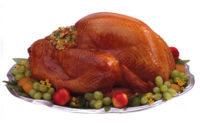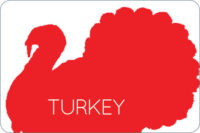Turkey: Challenges abound

An estimated 250 million turkeys will be raised in 2009, although all indicators show that production will be 8 percent less than last year. Hopefully the grain markets stay calm since feed costs are still 40 percent to 50 percent higher than three years ago. The industry is optimistic that there will be a general uptick in the economy and people will return to normal buying patterns, which would mean a stronger demand for all proteins.
The industry has seen a recovery in turkey product prices, which could be attributed to USDA’s three bonus purchases of turkey breast for the school lunch program. In total, USDA has purchased about $100 million of product.
Exports
Exports comprise about 10 percent of total turkey production. In 2008, 676 million pounds of turkey were exported. The top four export markets for U.S. turkey meat were Mexico (358.4 million pounds), China (85.6 million pounds), Russia (26.1 million pounds) and Canada (22.3 million pounds). The top three turkey products being exported are cooked dark meat (65.6 percent of the market), boneless dark meat (39.3 percent) and bone-in parts (33.6 percent). With the U.S. consumer gobbling up mostly white meat, the export market’s desire for dark meat products is important to the turkey industry’s economic health.
Environmental Challenges
Chesapeake Bay
The Environmental Protection Agency (EPA), USDA and Department of the Interior, in response to an executive order from the president, released a Chesapeake Bay restoration strategy. This strategy will be the launching pad for how this administration will deal with runoff from animal agriculture and will be viewed as a national model for nutrient reduction requirements for agriculture and other sectors. The recommendations will contain new, more rigorous accountability and regulatory elements that will place additional demands on the poultry industry to reach specified goals with accompanying practices.
The turkey industry currently operates under stringent environmental regulations, and it is important for the poultry industry to educate the public about the positive progress made in the Chesapeake and the industry’s commitment as good environmental stewards. In its reports on the bay, EPA has acknowledged that agriculture has made progress in attaining its nutrient and sediment reduction goals, as opposed to other sources, such as urban development and construction sources. In fact, these sources have been moving in the opposite direction and getting worse. While animal agriculture will remain a target for regulations, strides have been made in enhancing our environmental practices and we will continue towards further reducing nutrient and sediment levels.
The turkey industry is committed to sound environmental stewardship with a commitment to control air releases and water discharge that result from poultry production. Each turkey producer ensures they are in full compliance with any local and state environmental laws and regulations. The federation also provides Environmental Management Guidelines to ensure the best management practices for the industry.
Climate Change
The turkey industry supports environmental sustainability as part of its Turkey Industry Principles, adhering to environmental best management practices and continuing to reduce its already minimal environmental footprint as production increases have occurred.
While the industry firmly supports promoting environmental sustainability, it remains concerned that increases in the cost of production caused by climate-change legislation will not be balanced by any potential benefits derived from a carbon offsets market — an incentive-based program that allows companies to capitalize on reducing greenhouse gas emissions. The vertically integrated turkey industry operates on narrow margins and cannot easily pass increased costs on to consumers, yet higher production costs will ultimately result in higher food prices.
Climate legislation has the potential to significantly increase transportation and energy costs for poultry producers at a time when they are already suffering through severe economic hardship because of other federal policies and trade restrictions.
Ethanol
Ethanol has become part of the climate change debate as current cap-and-trade legislation could shift 40 million to 70 million acres of cropland out of production at the same time government is mandating corn-based ethanol blend levels. Although the turkey industry has spent more than $1 billion in additional feed costs because of the Renewable Fuels Standard (RFS), EPA is still considering increasing the blend from E10 to E15.
The industry can be somewhat optimistic with the introduction in the Senate of legislation targeting expansion of ethanol blends from 10 percent to 15 percent. The bill seeks to guarantee that mid-level blends are not approved unless EPA can demonstrate their compatibility with both road and non-road engines and vehicle emissions requirements. The bill also requires EPA’s Science Advisory Board to conduct comprehensive studies on the effects of mid-level ethanol fuels before approving any waiver of requirements under the Clean Air Act.
Food Safety
The turkey industry’s top priority is to maintain and enhance the public’s confidence in the safety of the food supply. NTF and its members have expressed concern over giving FDA new authority to conduct on-farm inspection of poultry and livestock operations, and supports legislation that recognizes USDA’s authorities regarding products, facilities and farms raising poultry and livestock. NTF has also expressed concern for granting FDA mandatory recall and civil penalty authority, imposing industry user fees and authority to dictate specific elements of company food-safety plans.
NTF also participated in a hearing before the House Agriculture Committee that stemmed from the full House of Representatives’ consideration of the Food Safety Enhancement Act of 2009. NTF and other witnesses told the House Agriculture Committee of their reservations about FDA’s ability to regulate the entire spectrum of the agricultural food system and expressed support for the bill’s meat and poultry exemption. The bill passed the House (but not before FDA’s new on-farm authority was stripped from the measure) and is now being debated in the Senate.
NTF and other agribusiness associations continue to convey concern over deficiencies the bill still possesses, such as civil penalties and traceability requirements, as the legislation could set a precedent for USDA’s livestock and poultry authority at a later time.
Looking for a reprint of this article?
From high-res PDFs to custom plaques, order your copy today!




